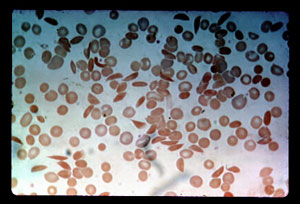Quadratic Functions Applications
Population Genetics
Problem 5- Find the frequency of the A allele that will maximize the mean fitness of a population.
Suppose there is a gene locus with two alleles, A and S, and suppose further that there is natural selection at this locus. In particular, the fitness values of genotypes AA, AS, and SS are w11, w12, and w22, respectively. If we let p and q represent the frequencies of the A and S alleles, respectively, we define the mean fitness of the population as follows,
Using these fitness values and the equation for mean fitness
[1] Allison, A.C. 1956. The sickle-cell and hemoglobin C genes in some African populations. Ann. Hum. Genet. 21: 67-89.
|
Problem 6- Find the frequency of the A allele that corresponds to a given mean fitness.
The Biology Project > Biomath > Quadratic Functions > Applications > Population Genetics
Department of Biochemistry and Molecular Biophysics
The University of Arizona
May 2006
Contact the Development Team
http://www.biology.arizona.edu All contents copyright © 2006. All rights reserved.
